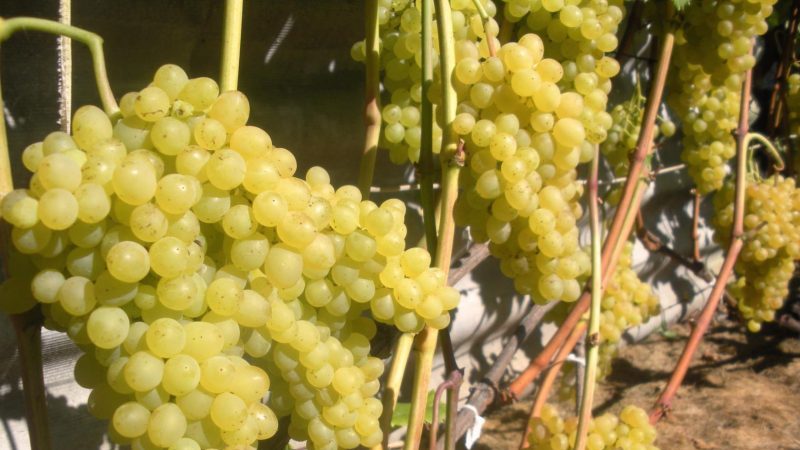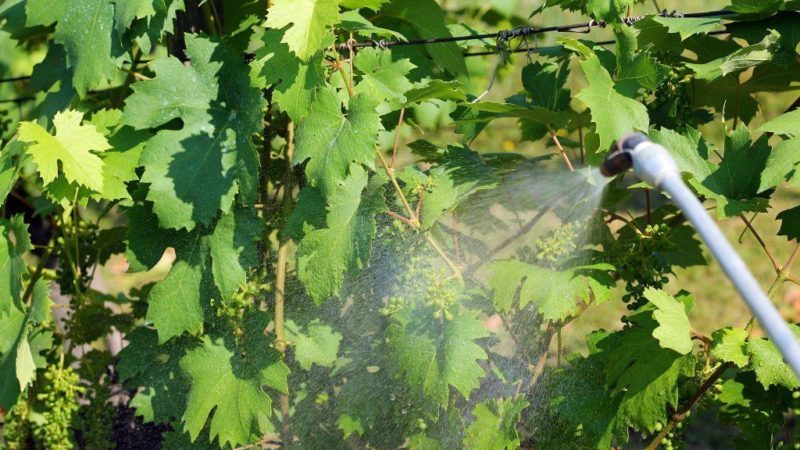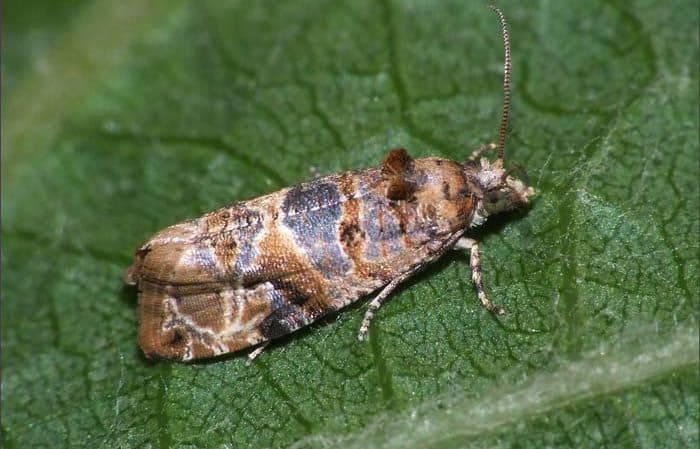Description of the grape variety Kishmish 342
Hybrid grape Kishmish 342 is a product of breeding work by Hungarian scientists. The culture quickly gained popularity among winegrowers due to its early ripening period, pleasant, balanced taste of berries with golden-pink, thin skin and a slight muscat flavor. The grapes are suitable for growing in the south of Russia, in the regions of the middle zone and in the zone of risky farming.
Description of grapes Kishmish 342
Kishmish 342 is a hybrid of the Villars blanc variety and the Perlette Sidlis sultana. Hungarian breeders worked on the creation of the cultivar.
Other names for the hybrid are Hungarian Kishmish, GF 342. The grapes are used for fresh consumption and for preparing raisins. Kishmish 342 is characterized by early ripening and resistance to frost - down to -24...-26°C.
Appearance and characteristics

The crop is characterized by high growth vigor; the crop ripens in 110–115 days from the moment the ovaries appear. The harvest is harvested from August to September depending on the growing zone.
The shoots ripen at 2/3 of the vine length, the fruitfulness of the shoots is 80–85% if pruned to 7-8 buds. The recommended load per bush is 35-40 eyes.
The bushes grow strongly, large clusters weighing 0.3-0.6 kg are formed on perennial branches. The shape is cylindrical-conical, the density is moderate. 2-3 bunches are left on one shoot. With proper care, the weight of one is 1-1.5 kg. The leaves are large, rounded, slightly dissected. The flowers are bisexual, collected in dense panicle inflorescences.
The berries are often medium-sized, less often large, 15×17 mm, weighing 2-3 g, belong to the 2-3 seedless class, rudiments are slightly present.
The pulp is juicy, fleshy, elastic. The taste is sweet, with a slight nutmeg aftertaste. Moderate sugar content and acidity are responsible for the harmony of taste. Even not completely ripe berries are moderately sweet. Sugar content - 20%, acidity - 6-8 g/l. The skin is thin and tender, green-golden at the beginning of berry ripening and light yellow with a slight pinkish tint at the moment of full ripeness.
Kishmish 342 is planted next to varieties that need pollination due to their high pollinating abilities. The hybrid is prone to strong growth, so it needs a strong support 2-3 m high and a large feeding area. To obtain large bunches weighing at least 500 g, the vine is tied so that the vineyard is ventilated and illuminated from all sides.
Often the bunches are kept until the end of September so that the berries have time to gain sugar and turn pink-brown. Kishmish 342 is not prone to cracking and rotting in wet weather. The bunches remain marketable for about a month after harvest. Productivity - 20-22 kg per bush. Small berries on medium-density clusters turn into raisins right on the bush.
Advantages and disadvantages

Benefits of culture:
- the possibility of growing in risky farming areas;
- frost resistance;
- balance of sugar and acid;
- seedlessness;
- preservation of presentation for up to one month;
- possibility of transportation over long distances;
- high productivity;
- resistance to fungal diseases;
- high survival rate of seedlings.
Flaws:
- peas caused by improperly shaped bushes;
- tendency to raisin when stored on the bush.
Features of cultivation
Kishmish 342 is successfully grown in regions of risky agriculture, placing vineyards in sunny areas with fertile soil. In the first year after planting, grapes need regular watering, loosening and fertilizing, pinching shoots 3 months after planting. The first harvest is harvested after 2-3 years.
To plant a hybrid, choose a spacious area in the south or southwest. The illumination must be full. Grapes are often planted on the south side of fences and houses, protecting the plant from gusty winds. Seedlings are planted at intervals of 1-1.5 m, maintaining a row spacing of 3-4 m. The tall-stemmed hybrid grows best on stable wooden or metal trellises.
This is interesting:
Description of grape varieties for Krasnodar
Landing rules
Planting of grapes is carried out in the spring, when the soil warms up and dries out, and the air temperature reaches +12...+15°C. Seedlings with a developed root system are planted in late April - early May, and those with a closed root system - in early June.
The site is prepared in the fall: it is dug up and organic matter and humus are added to increase fertility.. Vine rows form across the slope in the direction from north to southwest or south.
A young seedling should have more than 3 roots 8-10 cm long and 2-3 mm thick. Damaged roots are cut to 15-20 cm and immersed in a growth stimulator (Kornevin, sodium humate) and hexachlorane (100 g) for 15 minutes.
In the prepared area, dig a hole measuring 100x100 cm and 90 cm deep. 15-20 cm of expanded clay, crushed stone, broken brick are placed at the bottom, leveled and compacted. A pipe for irrigation is driven into the side of the pit.The soil from the pit is mixed with 500 g of superphosphate, 500 g of wood ash, 2-3 buckets of humus and poured into the pit in a layer of 25-30 cm.
The seedling is immersed in the center and the roots are straightened. 2-3 buckets of clean soil removed from the top layer of soil are poured on top. 3 buckets of warm, settled water are poured into the pit. It is important to plant seedlings at the level of the root collar.
The pit is filled with soil mixed with turf and sand, without compacting it, then mulched with pine needles, old leaves, sawdust, and straw.
The young vine is cut into 2 eyes and shaded. A wooden stake is placed next to each seedling and watered through a pipe.
Care

Caring for the hybrid Kishmish 342 includes several stages:
- gartering of mature vines and pruning in May;
- pinching the plant to 2 leaves in June, removing shoots and fertilizing;
- pinching the tops of young grapes in July;
- re-application of fertilizers (phosphorus and potassium);
- prevention of pests and fungal diseases;
- gartering of shoots and bunches, removal of shoots, treatment with potash fertilizers in early August;
- Harvesting, abundant watering and stopping fertilizing in late August - early September.
During the period of grape growth, the soil without mulch is loosened once every 2-3 weeks and weeds are removed. Mulched soil is loosened once a month to improve aeration.
Kishmish 342 loves moisture. If there is a shortage of it, the roots grow 2-2.5 m deep. This leads to drying of the vine and loss of juiciness of the berries. The grapes are watered once every 3 weeks except during the rainy season. 40-50 liters of water are poured under a one- to two-year-old bush.
During the entire growing season, the vineyard is watered at least 4 times:
- at the moment of bud break;
- at the end of flowering;
- during the ripening period of berries;
- before wintering.
It is not recommended to water the grapes during the flowering period and use cold water for this.
Top dressing
Mineral fertilizers are applied twice: in June and late July. The crop needs feeding to grow strong vines and medium-density clusters.
Feeding mode:
- 5 g of potassium, 5 g of ammonium nitrate, 50 g of superphosphate per 10 liters of water - from the moment the juice flows;
- chicken droppings at the rate of 1 kg per 1 m² - in grooves 30-40 cm deep 3 weeks after removing the winter shelter;
- 80 g of urea, 80 g of potassium sulfate, 30 g of phosphorus per 30 liters of water - at the beginning of flowering, 15 liters per bush;
- spraying with fertilizers containing zinc, manganese, iron and potassium - after flowering.
How to trim

In the first year of the growing season, the grapes are not pruned; they are given the opportunity to form a strong vine. In the second year of development, weak shoots are cut off and bushes are formed, leaving 8-10 vines on one plant. To strengthen the root system, catarrh is performed - the root shoots above the ground are removed. The opening of buds is closely monitored and two shoots are not allowed to appear from one eye. The smaller shoot is cut off, the remaining one is tied to the trellis after reaching 30 cm in length.
Pruning is performed with disinfected pruning shears. The cuts on the sleeve side should be smooth and round. These branches bear a large number of fruiting vines. On young shoots with clusters, the cuts should be oblique to prevent moisture from flowing in.
Pinching is a mandatory procedure in which, after the second bunch, 5 leaves are left and the tip of the shoot behind the tendrils is cut off. The length of the vine should be 2-2.5 m. This way the berries receive a sufficient amount of nutritional components and gain sugar content.In the summer, pinching of excess greenery and tendrils is carried out to increase the yield and improve the health of the vine.
Proper wintering
In cold regions, at the end of autumn, the vine is carefully removed from its supports, twisted and lightly pressed to the ground. 20-30 cm of soil is poured on top and straw, spruce branches, pine needles, roofing material or agrofibre are laid. In the south, Kishmish 342 grapes are grown as a non-covered crop.
Pest Control

To prevent the development of fungal infections, preventive treatment of grapes is performed. In the spring, the vineyard is sprayed with solutions of Topaz, Radomil, and Bordeaux mixture.
Infection with mildew and oidium occurs rarely, only in the case of thickened plantings. Mildew appears in the form of moldy plaque and yellow spots on the leaves. With oidium, the foliage becomes covered with a gray coating, the berries crack and spoil, acquiring the smell of rotten fish. The disease appears in humid and hot weather.
Reference. To combat mildew, products containing kresoxim-methyl and copper are used. Treatment is performed twice every 14 days.
For the purpose of prevention, vineyards are sprayed with Actellik and Oksikhom before flowering. After the ovaries appear, the bushes are treated with contact-systemic fungicides “Thanos” and “Acrobat”. In case of severe damage, plants are sprayed with Quadris and Strobi. Fungicides are alternated to prevent fungi from becoming addicted.
Sweet, thin-skinned berries attract wasps. Mesh bags help protect the harvest. Each bunch is placed in a bag and tied tightly. Bait made from jam and honey with the addition of boric acid or sugar with chlorophos is placed next to the bushes.
The main pests of grapes are chafer larvae and leaf rollers.. To destroy them, insecticides “Fufanon”, “Fundazol”, and colloidal sulfur are used. The larvae of the cockchafer live in the tree trunk and damage the roots. One of the most effective methods for exterminating them is watering with a solution of potassium permanganate (5 g per 10 liters of water) or insecticides “Karbofos” or “Decis”. Treatment with chemicals is carried out in early June until the grapes ripen.

Reviews
Hybrid Kishmish 342 occupies a worthy place in the vineyards of Russian gardeners. Many appreciated its taste, ease of care and resistance to diseases. Reviews about Kishmish 342 are more than positive.
Vera, Borisoglebsk: “Since I studied the description of the Kishmish 342 grape variety, it occupies half of our vineyard. I like it for its undemanding nature in terms of soil composition and the absence of problems with cultivation. The grapes are resistant to mildew and oidium. In 10 years of care, I only had to fight mildew once, and only because the summer was rainy. My husband specially prepares a herbal infusion based on nettle, wormwood, chamomile, yarrow, dandelion, and burdock for watering the bushes. The warm infusion is poured into a bucket, chicken droppings and 500 ml of wood ash are added. He fertilizes plants with this chatter to prevent diseases and increase productivity.”
Maria, Kursk: “The grape variety Kishmish 342, or, more precisely, a hybrid, ripens in our area in early August, but I begin to pluck the tops already in July. For the winter I cover it with spruce branches; I haven’t tested it for winter hardiness, but if you believe what is stated, the plant can withstand frosts down to -26°C. I do 2-3 treatments with Bordeaux mixture against mildew; I have never seen oidium. The berries are very juicy, sweet, and have a pleasant golden-pink color.There are no seeds, and the skin is thin and imperceptible. The largest bunch weighed 800 g. I leave the bunches on the bushes and wait for the berries to dry for raisins.”
This is interesting:
Hybrid grape Kesha - description and characteristics
Conclusion
Kishmish grape varieties and hybrids are highly valued in many countries for their pleasant sweet taste and absence of seeds. Kishmish 342 is one of them. The cultivar is grown everywhere due to its adaptation to any weather conditions. Grapes can withstand frosts down to -26°C, so in the south they are grown as an uncovered crop, and in regions with harsher winters they are covered.
The berries have a harmonious taste due to their moderate acid content and are prone to raisining when picked late. Caring for the vineyard is simple: just control watering, apply potassium-phosphorus fertilizers, carry out pruning and preventive treatments.